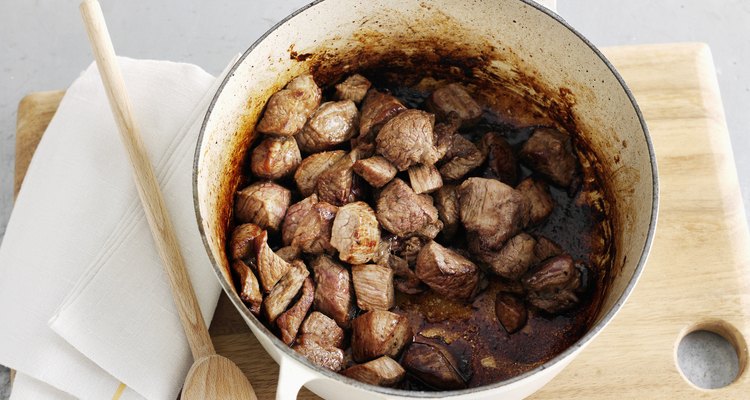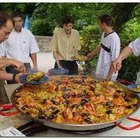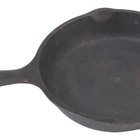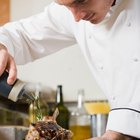
Cultura RM Exclusive/BRETT STEVENS/Cultura Exclusive/GettyImages
Choosing pans for electric stove tops can be confusing with so many options. Ceramic pots and pans are compatible with most types of electric stove tops, but it's a good idea to read the owner's guide with the cookware to make sure you're using it correctly. Ceramic cookware is durable, versatile and long-lasting and works in the microwave, on gas stoves and on most electric stoves. You can also use it in your refrigerator and dishwasher.
Electric Stove Tops
Electric stoves vary in burner design and power. Traditionally, electric stove tops feature raised, flat coils that grow hot with heat generated by electricity. Because of the way heat radiates from electric coil burners, you can use a lower heat setting with ceramic cookware than when cooking on a gas stove.
Some electric stove burners feature a solid disk rather than the coils typically seen. These solid disks are easier to clean as there are no crevices or holes to accumulate soot, burned food or grease as on a traditional coil burner. Ceramic cookware used on solid disk-style burners takes longer to cook, however, as the disks heat at a slower rate than coil burners.
Glass-Topped Electric Stove Tops
Glass-topped electric stoves are sometimes referred to as flat-topped stoves because the burner is encased beneath a flat layer of glass. An illustration or a painted ring may be used to show where the burner is beneath the glass.
The burner beneath the glass may be a radiant or halogen burner. Ceramic cookware can be used on both of these type burners, but ceramic is so durable and hard that the cookware can actually damage the glass stove top. Take careful precautions when you use ceramic on electric stove tops.
Never slide or scoot the pan or pot over the glass stove top, or the ceramic cookware will scratch the surface. Ceramic cookware with grooves or textured bottoms may not cook evenly on glass-topped stove tops because the burner requires direct glass-to-pan-bottom contact to evenly distribute heat for cooking. Use flat-bottomed ceramic cookware for the best results.
Electric Induction Stove
You cannot use ceramic cookware on an induction stove top. Induction stoves require cookware made of stainless steel or iron. Cookware made of ceramic, glass, solid aluminum or copper cannot conduct the heat generated by an induction burner throughout the pan. An induction burner works with the metal pan to cook the food within instead of simply heating up a burner coil, disk or element beneath the cookware. Ceramic cookware is useless on an induction stove.
Ceramic Cookware Considerations
Even though ceramic cookware is durable, it can be broken or chipped if mistreated. Store ceramic cookware with other ceramic cookware and not with metal pots and pans.
Ceramic cookware gets hot just like any other pot and will burn skin if hot. Use potholders when the cookware is hot to avoid injury. Emile Henry cookware, for instance, is made to function in temperatures up to 480 degrees Fahrenheit.
Hot ceramic pots and pans should be placed on a trivet, hot pad, potholder or towel when placed onto table or counter surfaces to avoid damaging those surfaces. For best results, always have food within the ceramic cookware before heating.
Related Articles

What is a Paella Pan?

What Is the Best Cookware for Electric ...

What Is Magnalite?

Can I Cook With Porcelain Enamel on a ...

How to Use Smartware Cookware
How to Lower Cooking Times & ...

How to Use an Iron Skillet on a Ceramic ...

Can You Use a Glass Pan to Cook a Roast?

Does Heat Transfer Evenly Through ...

Are Halogen Heat & Infrared Waves Safe ...

What Is Better for Cookware: Glass, ...

What Kind of Pan Can I Use to Cook a ...

Glass Pie Pan Baking Tips

Anodized Vs. Teflon in Cookware

What "Tools of the Trade" Cookware is ...

Heating Foods in Plastic & BPA

Are Nickel Lined Pans Safe?
Dutch Oven Vs. Cooking Pot

How to Cook With a Gas Fireplace

The Difference Between a Chafing Dish & ...
References
Resources
Writer Bio
Louise Harding holds a B.A. in English language arts and is a licensed teacher. Harding is a professional fiction writer. She is mother to four children, two adopted internationally, and has had small businesses involving sewing and crafting for children and the home. Harding's frugal domestic skills help readers save money around the home.